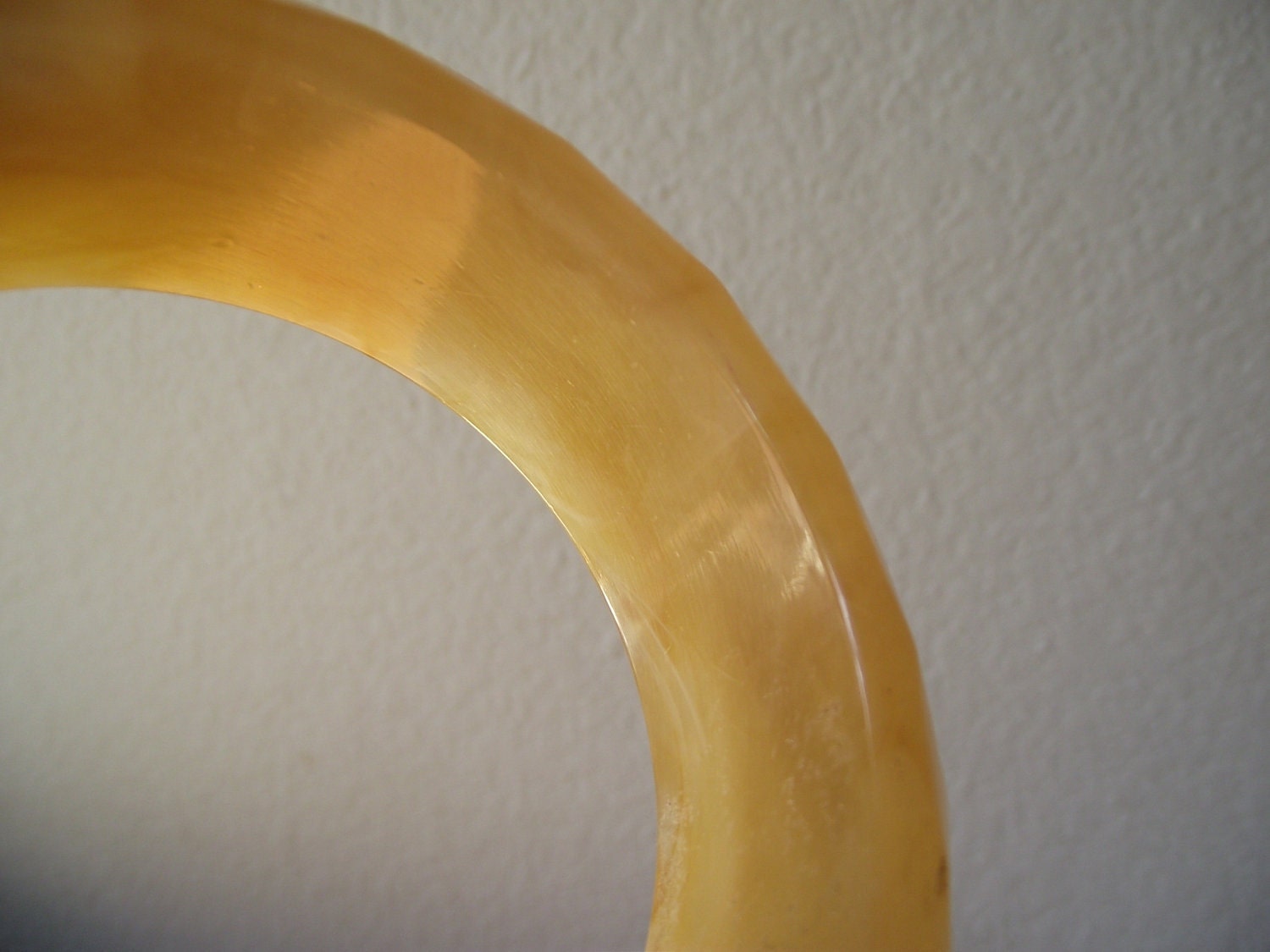or polyoxybenzylmethylenglycolanhydride, is an early plastic. It is a thermosetting phenol formaldehyde resin, formed from an elimination reaction of phenol with formaldehyde, usually with a wood flour filler. It was developed in 1907 by Belgian chemist Leo Baekeland. (thank you Wikipedia)
Bakelite does not conduct heat and has been designated as a National Historical Landmark Chemical for being the worlds first synthetic plastic. It can be carved, but has no mold marks like you normally see on a modern piece of plastic. It yellows with age in a distinct way that collectors recognize quickly.
 My first encounter with Bakelite came in a pumpkin orange bracelet I bought at a garage sale in Michigan for about a dollar. That was when eBay was hot and I was quickly able to research it, learn the tests for bakelite and immediately sell it for around 45 dollars as I recall. After that, I was hooked on Bakelite and have looked for it ever since. I've had many bracelets over the years, flatware, earrings, chromeware and furniture pulls. There is just something about it that collectors love...and I am with them.
My first encounter with Bakelite came in a pumpkin orange bracelet I bought at a garage sale in Michigan for about a dollar. That was when eBay was hot and I was quickly able to research it, learn the tests for bakelite and immediately sell it for around 45 dollars as I recall. After that, I was hooked on Bakelite and have looked for it ever since. I've had many bracelets over the years, flatware, earrings, chromeware and furniture pulls. There is just something about it that collectors love...and I am with them.You can test Bakelite in several ways: my favorite it to dip it in hot water and see if it brings out a smell of formaldahyde. Other ways include using Formula 409 cleaner on q-tip or simichrome polish swabbed across a piece to see yellowing on the cotton swab. The hot-pin test is naughty and should not be applied because it ruins the piece when the tester heats up a straight pin with a match and then pokes the item to see how it is affected by heat. I find non-Bakelite bracelets with burn marks in them all the time from people testing them this way. When you become more familiar with Bakelite, you can do the a simple visual and tactile test, looking for light scratches that new plastic doesn't have because it isn't old enough. Bakelite is also heavier than new plastic. It is dense and makes a gorgeous sound when two true Bakelite bracelets clink together.
 While a modern plastic bangle has little value, a Bakelite collector expects to pay as much as 5000 dollars for a rare, carved, inlaid or extra large bangle. Of course, with those kind of possibilities there are fakes and reproductions, so you have to be cautious.
While a modern plastic bangle has little value, a Bakelite collector expects to pay as much as 5000 dollars for a rare, carved, inlaid or extra large bangle. Of course, with those kind of possibilities there are fakes and reproductions, so you have to be cautious.Bakelite is still used today in everyday things like brake pads and cooking pan handles, but not for decorative items because it is labor intensive to make. Searching for old Bakelite is one my favorite treasure hunts. You never know when or where you will find it, but I assure you, I am always looking.
(All of the pictures included are items I have sold in my etsy store. I have one bracelet available currently found here.)










4 comments:
:-) I just bought some Bakelite pieces this past weekend -- I use the 'old radio' test. Rub your finger back and forth on it until the spot gets pretty warm and then sniff to see if it smells like an old radio.
Very scientific.
This is something I never think to consider because I am completely unsure of having any ability to detect it. I wonder how much I've missed over the last 25-years?
Into Vintage, I was right there with you till you said 'see if it smells like an old radio'... well, shoot, I ain't exactly sure what an old radio smells like!
Great read, Ness! Happy hunting!
that bracelet you have on etsy is gorgeous! I'd buy it but rarely do the bangle bracelets fit over my hand! I'm gonna start keeping my eye out for this, and I think I can remember what an old radio smells like too! ac
Post a Comment